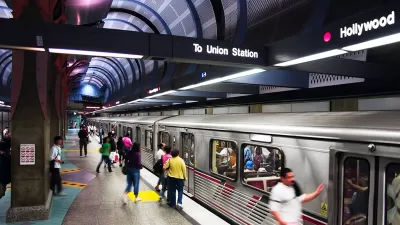Los Angeles Metro's new Gold Line light rail extension is attracting riders from the regional Metrolink commuter rail line that serves San Bernardino. The editorial board of the Daily Bulletin suggests that's not necessarily a problem.
Transit redundancy is a good thing, especially when one mode is unable to operate, be it by labor strike, mechanical breakdown, derailment or natural disaster. More commonly, the more options a commuter has to driving, the better it is for reducing congestion and improving the environment.
But as Planetizen editor James Brasuell posted July 31, the competition between two rail modes in Southern California appears like transit cannibalization.
"There’s a bit of friction between Metrolink and L.A. Metro as the latter’s rails reach toward the Inland Empire," observes the Inland Valley Daily Bulletin editorial board. "But we’re confident they can work it out and manage to serve complementary, sometimes overlapping constituencies of passengers."
The opening in March last year of the 6-station, 11.5-mile, first phase of Los Angeles Metro's Gold Line Foothill (light rail) Extension to Azusa in the San Gabriel Valley has unexpectedly resulted in attracting riders from Metrolink's San Bernardino commuter rail line (see schedule). Thousands have switched to the more frequent [see schedule (pdf)] light rail train costing only $1.75 for an adult ride, regardless of trip length.
"And that trend figures to grow as the 12.3-mile, six-station Foothill Gold Line light rail extension from Azusa to Claremont and then Montclair," adds the editorial. The opening of the extension has been delayed two years and is expected to open by December 2025 or early 2026,
Between January and March, Metrolink lost 25 percent of its boardings at its [station in Covina, Los Angeles County], which is just four miles from the popular Gold Line’s Azusa Pacific/Citrus College station that opened March 5.
The editorial board opines that "[c]onnectivity of transportation systems — rail or otherwise — is always a good thing...[s]o there should be no going back on plans for the two rail lines to meet up in Pomona, Claremont and Montclair." They point to Metrolink's advantages – "It’s faster, with fewer stops, more comfortable and has tables where riders can work or play" to distinguish the two rail modes.
Less-frequent, more expensive, but faster and more comfortable commuter rail competes with heavy rail in many of the nation's larger cities, such as Planetizen reader SuperChief49 observed in the relationship between Metra and Chicago Transit Authority or in Queens by the MTA subway and MTA's Long Island Rail Road.
Light rail and commuter rail competition should be no different. As the editorial concludes, L.A. Metro and Metrolink "should collaborate to plan for their lines to be efficient and complementary. Freeway congestion likely won’t ease any by the time the Gold Line arrives in Montclair years from now — so there will be enough riders to support both options."
Just the same, Metrolink should try to give its customers more reasons to keep riding their more expensive and far less-frequent trains. For example, the Bay Area's Caltrain commuter line saw ridership after so-called baby bullet service was launched in 2004, though the comparison is tenuous in that Caltrain's transit competition is mainly local bus service.
FULL STORY: Connectivity is key for transportation

Planetizen Federal Action Tracker
A weekly monitor of how Trump’s orders and actions are impacting planners and planning in America.

Restaurant Patios Were a Pandemic Win — Why Were They so Hard to Keep?
Social distancing requirements and changes in travel patterns prompted cities to pilot new uses for street and sidewalk space. Then it got complicated.

Map: Where Senate Republicans Want to Sell Your Public Lands
For public land advocates, the Senate Republicans’ proposal to sell millions of acres of public land in the West is “the biggest fight of their careers.”

Orange County, Florida Adopts Largest US “Sprawl Repair” Code
The ‘Orange Code’ seeks to rectify decades of sprawl-inducing, car-oriented development.

Maui's Vacation Rental Debate Turns Ugly
Verbal attacks, misinformation campaigns and fistfights plague a high-stakes debate to convert thousands of vacation rentals into long-term housing.

San Francisco Suspends Traffic Calming Amidst Record Deaths
Citing “a challenging fiscal landscape,” the city will cease the program on the heels of 42 traffic deaths, including 24 pedestrians.
Urban Design for Planners 1: Software Tools
This six-course series explores essential urban design concepts using open source software and equips planners with the tools they need to participate fully in the urban design process.
Planning for Universal Design
Learn the tools for implementing Universal Design in planning regulations.
Heyer Gruel & Associates PA
JM Goldson LLC
Custer County Colorado
City of Camden Redevelopment Agency
City of Astoria
Transportation Research & Education Center (TREC) at Portland State University
Camden Redevelopment Agency
City of Claremont
Municipality of Princeton (NJ)





























